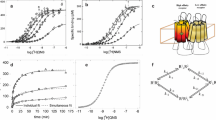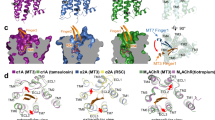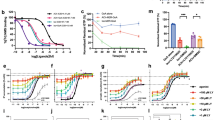Abstract
The five muscarinic acetylcholine receptors (M1–M5) are prototypical members of the superfamily of G-protein-coupled receptors (GPCRs). During the past decade, this laboratory has used different members of this receptor subfamily as model systems to study the molecular mechanisms involved in GPCR function. This article reviews recent investigations dealing with molecular aspects of M3 muscarinic receptor assembly and dimerization/oligomerization. Studies with coexpressed M3 receptor fragments and M3 muscarinic/α2C-adrenergic hybrid receptors showed that muscarinic receptors, like other GPCRs, are composed of multiple autonomous folding domains. Moreover, biochemical studies have provided direct evidence for the formation of M3 receptor dimers/oligomers. These high molecular mass receptor species are expressed on the cell surface and can bind muscarinic ligands. M3 receptor dimerization/oligomerization appears to be receptor subtype-selective and involves both non-covalent interactions as well as disulfide-crosslinking of receptor monomers. These studies add to the growing number of reports suggesting the existence of GPCR dimers or multimers. The precise functional characteristics of such receptor aggregates remain to be elucidated.
Similar content being viewed by others
Log in or create a free account to read this content
Gain free access to this article, as well as selected content from this journal and more on nature.com
or
References
AbdAlla S, Zaki E, Lother H, Quitterer U . (1999): Involvement of the amino terminus of the B2 receptor in agonist-induced receptor dimerization. J Biol Chem 274: 26079–26084
Bai M, Trivedi S, Brown EM . (1998): Dimerization of the extracellular calcium-sensing receptor (CaR) on the cell surface of CaR-transfected HEK293 cells. J Biol Chem 273: 23605–23610
Bai M, Trivedi S, Kifor O, Quinn SJ, Brown EM . (1999): Intermolecular interactions between dimeric calcium-sensing receptor monomers are important for its normal function. Proc Natl Acad Sci USA 96: 2834–2839
Bonner TI, Buckley NJ, Young AC, Brann MR . (1987): Identification of a family of muscarinic acetylcholine receptor genes. Science 237: 527–532
Chidiac P, Green MA, Pawagi AB, Wells JW . (1997): Cardiac muscarinic receptors. Cooperativity as the basis for multiple states of affinity. Biochemistry 36: 7361–7379
Curtis CAM, Wheatley M, Bansal S, Birdsall NJM, Eveleigh P, Pedder EK, Poyner D, Hulme EC . (1989): Propylbenzilylcholine mustard labels an acidic residue in transmembrane helix 3 of the muscarinic receptor. J Biol Chem 264: 489–495
Cvejic S, Devi LA . (1997): Dimerization of the δ opioid receptor: implication for a role in receptor internalization. J Biol Chem 272: 26959–26964
Goldsmith PK, Fan GF, Ray K, Shiloach J, McPhie P, Rogers KV, Spiegel AM . (1999): Expression, purification, and biochemical characterization of the amino-terminal extracellular domain of the human calcium receptor. J Biol Chem 274: 11303–11309
Gouldson PR, Snell CR, Bywater RP, Higgs C, Reynolds CA . (1998): Domain swapping in G-protein coupled receptor dimers. Protein Eng 11: 1181–1193
Grosse R, Schöneberg T, Schultz G, Gudermann T . (1997): Inhibition of gonadotropin-releasing hormone receptor signaling by expression of a splice variant of the human receptor. J Mol Endocrinol 11: 1305–1318
Haga K, Haga T . (1985): Purification of the muscarinic acetylcholine receptor from porcine brain. J Biol Chem 260: 7927–7935
Hebert TE, Moffett S, Morello J-P, Loisel TP, Bichet DG, Barret C, Bouvier M . (1996): A peptide derived from a β2-adrenergic receptor transmembrane domain inhibits both receptor dimerization and activation. J Biol Chem 271: 16384–16392
Hebert TE, Bouvier M . (1998): Structural and functional aspects of G protein-coupled receptor oligomerization. Biochem Cell Biol 76: 1–11
Hirschberg BT, Schimerlik MI . (1994): A kinetic model for oxotremorine M binding to recombinant porcine m2 muscarinic receptors expressed in Chinese hamster ovary cells. J Biol Chem 269: 26127–26135
Jones KA, Borowsky B, Tamm JA, Craig DA, Durkin MM, Dai M, Yao WJ, Johnson M, Gunwaldsen C, Huang LY, Tang C, Shen Q, Salon JA, Morse K, Laz T, Smith KE, Nagarathnam D, Noble SA, Branchek TA, Gerald C . (1998): GABAB receptors function as a heteromeric assembly of the subunits GABABR1 and GABABR2. Nature 1998 396: 674–679
Jordan BA, Devi LA . (1999): G-protein-coupled receptor heterodimerization modulates receptor function. Nature 399: 697–700
Kaupmann K, Malitschek B, Schuler V, Heid J, Froestl W, Beck P, Mosbacher J, Bischoff S, Kulik A, Shigemoto R, Karschin A, Bettler B . (1998): GABAB-receptor subtypes assemble into functional heteromeric complexes. Nature 396: 683–687
Kobilka BK, Kobilka TS, Daniel K, Regan JW, Caron MG, Lefkowitz RJ . (1988): Chimeric α2-, β2-adrenergic receptors: delineation of domains involved in effector coupling and ligand binding specificity. Science 240: 1310–1316
Kuner R, Kohr G, Grunewald S, Eisenhardt G, Bach A, Kornau HC . (1999): Role of heteromer formation in GABAB receptor function. Science 283: 74–77
Kurtenbach E, Curtis CAM, Pedder EK, Aitken A, Harris ACM, Hulme EC . (1990): Muscarinic acetylcholine receptors: peptide sequencing identifies residues involved in antagonist binding and disulfide bond formation. J Biol Chem 265: 13702–13708
Maggio R, Vogel Z, Wess J . (1993a): Coexpression studies with mutant muscarinic/adrenergic receptors provide evidence for intermolecular crosstalk between G protein-linked receptors. Proc Natl Acad Sci USA 90: 3103–3107
Maggio R, Vogel Z, Wess J . (1993b): Reconstitution of functional muscarinic receptors by coexpression of amino and carboxyl terminal receptor fragments. FEBS Lett 319: 195–200
Maggio R, Barbier P, Fornai F, Corsini GU . (1996): Functional role of the third cytoplasmic loop in muscarinic receptor dimerization. J Biol Chem 271: 31055–31060
Maggio R, Barbier P, Colelli A, Salvadori F, Demontis G, Corsini GU . (1999): G protein-linked receptors: pharmacological evidence for the formation of heterodimers. J Pharmacol Exp Ther 291: 251–257
Martin NP, Leavitt LM, Sommers CM, Dumont ME . (1999): Assembly of G protein-coupled receptors from fragments: identification of functional receptors with discontinuities in each of the loops connecting transmembrane segments. Biochemistry 38: 682–695
Monnot C, Bihoreau C, Conchon S, Curnow KM, Corvol P, Clauser E . (1996): Polar residues in the transmembrane domains of the type 1 angiotensin II receptor are required for binding and coupling: reconstitution of the binding site by co-expression of two deficient mutants. J Biol Chem 271: 1507–1513
Ng GYK, O'Dowd BF, Lee SP, Chung HT, Brann MR, Seeman P, George SR . (1996): Dopamine D2 receptor dimers and receptor-blocking peptides. Biochem Biophys Res Commun 227: 200–204
Nielsen SM, Elling CE, Schwartz TW . (1998): Split-receptors in the tachykinin neurokinin-1 system — mutational analysis of intracellular loop 3. Eur J Biochem 251: 217–226
Nimchinsky EA, Hof PR, Janssen WGM, Morrison JH, Schmauss C . (1997): Expression of Dopamine D3 receptor dimers and tetramers in brain and in transfected cells. J Biol Chem 272: 29229–29237
Okamoto T, Sekiyama N, Otsu M, Shimada Y, Sato A, Nakanishi S, Jingami H . (1998): Expression and purification of the extracellular ligand binding region of metabotropic glutamate receptor subtype 1. J Biol Chem 273: 13089–13096
Osuga Y, Hayashi M, Kudo M, Conti M, Kobilka B, Hsueh AJ . (1997): Co-expression of defective luteinizing hormone receptor fragments partially reconstitutes ligand-induced signal generation. J Biol Chem 272: 25006–25012
Pace AJ, Gama L, Breitwieser GE . (1999): Dimerization of the calcium-sensing receptor occurs within the extracellular domain and is eliminated by Cys –> Ser mutations at Cys101 and Cys236. J Biol Chem 274: 11629–11634
Popot J-L, Engelman DM . (1990): Membrane protein folding and oligomerization: the two-stage model. Biochemistry 29: 4031–4037
Potter LT, Ballesteros LA, Bichajian LH, Ferrendelli CA, Fisher A, Hanchett HE, Zhang R . (1991): Evidence for paired M2 muscarinic receptors. Mol Pharmacol 39: 211–221
Ray K, Hauschild BC, Steinbach PJ, Goldsmith PK, Hauache O, Spiegel AM . (1999): Identification of the cysteine residues in the amino-terminal extracellular domain of the human Ca2+ receptor critical for dimerization. Implications for function of monomeric Ca2+ receptor. J Biol Chem 274: 27642–27650
Ridge KD, Lee SSJ, Yao LL . (1995): In vivo assembly of rhodopsin from expressed polypeptide fragments. Proc Natl Acad Sci USA 92: 3204–3208
Robbins MJ, Ciruela F, Rhodes A, McIlhinney RAJ . (1999): Characterization of the dimerization of metabotropic glutamate receptors using an N-terminal truncation of mGluR1a. J Neurochem 72: 2539–2547
Romano C, Yang W-L, O'Malley KL . (1996): Metabotropic glutamate receptor 5 is a disulfide-linked dimer. J Biol Chem 271: 28612–28616
Schöneberg T, Liu J, Wess J . (1995): Plasma membrane localization and functional rescue of truncated forms of a G protein-coupled receptor. J Biol Chem 270: 18000–18006
Schöneberg T, Yun J, Wenkert D, Wess J . (1996): Functional rescue of mutant V2 vasopressin receptors causing nephrogenic diabetes insipidus by a coexpressed receptor polypeptide. EMBO J 15: 1283–1291
Schöneberg T, Sandig V, Wess J, Gudermann T, Schultz G . (1997): Reconstitution of mutant V2 vasopressin receptors by adenovirus-mediated gene transfer. Molecular basis and clinical implication. J Clin Invest 100: 1547–1556
Strader CD, Fong TM, Tota MR, Underwood D, Dixon RAF . (1994): Structure and function of G protein-coupled receptors. Annu Rev Biochem 63: 101–132
Ward DT, Brown EM, Harris HW . (1998): Disulfide bonds in the extracellular calcium-polyvalent cation-sensing receptor correlate with dimer formation and its response to divalent cations in vitro. J Biol Chem 273: 14476–14483
Watson S, Arkinstall S . (1994): Superfamily of seven transmembrane proteins. In Watson S, Arkinstall S (eds), The G-Protein Linked Receptor — Facts Book. London, Academic Press, pp 1–294
Wess J . (1996): Molecular biology of muscarinic acetylcholine receptors. Crit Rev Neurobiol 10: 69–99
Wess J . (1998): Molecular basis of receptor/G protein coupling selectivity. Pharmacol Ther 80: 231–264
Wess J, Brann MR, Bonner TI . (1989): Identification of a small intracellular region of the muscarinic m3 receptor as a determinant of selective coupling to PI turnover. FEBS Lett 258: 133–136
White JH, Wise A, Main MJ, Green A, Fraser NJ, Disney GH, Barnes AA, Emson P, Foord SM, Marshall FH . (1998): Heterodimerization is required for the formation of a functional GABAB receptor. Nature 396: 679–682
Wreggett KA, Wells JW . (1995): Cooperativity manifest in the binding properties of purified cardiac muscarinic receptors. J Biol Chem 270: 22488–22499
Yu H, Kono M, McKee TD, Oprian DD . (1995): A general method for mapping tertiary contacts between amino acid residues in membrane-embedded proteins. Biochemistry 34: 14963–14969
Zeng FY, Wess J . (1999): Identification and molecular characterization of m3 muscarinic receptor dimers. J Biol Chem 274: 19487–19497
Zeng FY, Soldner A, Schöneberg T, Wess J . (1999): Conserved extracellular cysteine pair in the M3 muscarinic acetylcholine receptor is essential for proper receptor cell surface localization but not for G protein coupling. J Neurochem 72: 2404–2414
Author information
Authors and Affiliations
Corresponding author
Rights and permissions
About this article
Cite this article
Zeng, FY., Wess, J. Molecular Aspects of Muscarinic Receptor Dimerization. Neuropsychopharmacol 23 (Suppl 1), S19–S31 (2000). https://doi.org/10.1016/S0893-133X(00)00146-9
Received:
Accepted:
Issue date:
DOI: https://doi.org/10.1016/S0893-133X(00)00146-9
Keywords
This article is cited by
-
Differential distributions and trafficking properties of dopamine D1 and D5 receptors in nerve cells
Neuroscience Bulletin (2009)
-
Dimerization Between Vasopressin V1b and Corticotropin Releasing Hormone Type 1 Receptors
Cellular and Molecular Neurobiology (2007)
-
Acetylcholine
British Journal of Pharmacology (2006)
-
Characterization of contractile function and expression of muscarinic receptors, G proteins and adenylate cyclase in cultured tracheal smooth muscle of swine
Journal of Biomedical Science (2002)



